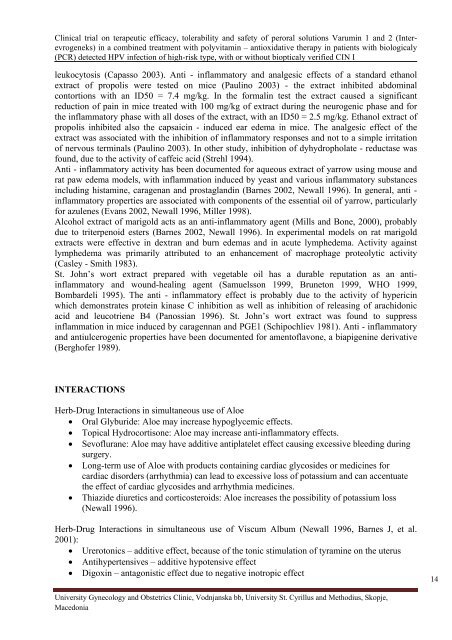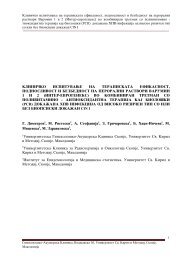klini^ko ispituvawe na terapiskata efikasnost, podnoslivost i
klini^ko ispituvawe na terapiskata efikasnost, podnoslivost i
klini^ko ispituvawe na terapiskata efikasnost, podnoslivost i
Create successful ePaper yourself
Turn your PDF publications into a flip-book with our unique Google optimized e-Paper software.
Clinical trial on terapeutic efficacy, tolerability and safety of peroral solutions Varumin 1 and 2 (Interevrogeneks)<br />
in a combined treatment with polyvitamin – antioxidative therapy in patients with biologicaly<br />
(PCR) detected HPV infection of high-risk type, with or without biopticaly verified CIN I<br />
leukocytosis (Capasso 2003). Anti - inflammatory and a<strong>na</strong>lgesic effects of a standard ethanol<br />
extract of propolis were tested on mice (Paulino 2003) - the extract inhibited abdomi<strong>na</strong>l<br />
contortions with an ID50 = 7.4 mg/kg. In the formalin test the extract caused a significant<br />
reduction of pain in mice treated with 100 mg/kg of extract during the neurogenic phase and for<br />
the inflammatory phase with all doses of the extract, with an ID50 = 2.5 mg/kg. Ethanol extract of<br />
propolis inhibited also the capsaicin - induced ear edema in mice. The a<strong>na</strong>lgesic effect of the<br />
extract was associated with the inhibition of inflammatory responses and not to a simple irritation<br />
of nervous termi<strong>na</strong>ls (Paulino 2003). In other study, inhibition of dyhydropholate - reductase was<br />
found, due to the activity of caffeic acid (Strehl 1994).<br />
Anti - inflammatory activity has been documented for aqueous extract of yarrow using mouse and<br />
rat paw edema models, with inflammation induced by yeast and various inflammatory substances<br />
including histamine, carage<strong>na</strong>n and prostaglandin (Barnes 2002, Newall 1996). In general, anti -<br />
inflammatory properties are associated with components of the essential oil of yarrow, particularly<br />
for azulenes (Evans 2002, Newall 1996, Miller 1998).<br />
Alcohol extract of marigold acts as an anti-inflammatory agent (Mills and Bone, 2000), probably<br />
due to triterpenoid esters (Barnes 2002, Newall 1996). In experimental models on rat marigold<br />
extracts were effective in dextran and burn edemas and in acute lymphedema. Activity against<br />
lymphedema was primarily attributed to an enhancement of macrophage proteolytic activity<br />
(Casley - Smith 1983).<br />
St. John’s wort extract prepared with vegetable oil has a durable reputation as an anti-<br />
inflammatory and wound-healing agent (Samuelsson 1999, Bruneton 1999, WHO 1999,<br />
Bombardeli 1995). The anti - inflammatory effect is probably due to the activity of hypericin<br />
which demonstrates protein ki<strong>na</strong>se C inhibition as well as inhibition of releasing of arachidonic<br />
acid and leucotriene B4 (Panossian 1996). St. John’s wort extract was found to suppress<br />
inflammation in mice induced by caragen<strong>na</strong>n and PGE1 (Schipochliev 1981). Anti - inflammatory<br />
and antiulcerogenic properties have been documented for amentoflavone, a biapigenine derivative<br />
(Berghofer 1989).<br />
INTERACTIONS<br />
Herb-Drug Interactions in simultaneous use of Aloe<br />
• Oral Glyburide: Aloe may increase hypoglycemic effects.<br />
• Topical Hydrocortisone: Aloe may increase anti-inflammatory effects.<br />
• Sevoflurane: Aloe may have additive antiplatelet effect causing excessive bleeding during<br />
surgery.<br />
• Long-term use of Aloe with products containing cardiac glycosides or medicines for<br />
cardiac disorders (arrhythmia) can lead to excessive loss of potassium and can accentuate<br />
the effect of cardiac glycosides and arrhythmia medicines.<br />
• Thiazide diuretics and corticosteroids: Aloe increases the possibility of potassium loss<br />
(Newall 1996).<br />
Herb-Drug Interactions in simultaneous use of Viscum Album (Newall 1996, Barnes J, et al.<br />
2001):<br />
• Urerotonics – additive effect, because of the tonic stimulation of tyramine on the uterus<br />
• Antihypertensives – additive hypotensive effect<br />
• Digoxin – antagonistic effect due to negative inotropic effect<br />
University Gynecology and Obstetrics Clinic, Vodnjanska bb, University St. Cyrillus and Methodius, Skopje,<br />
Macedonia<br />
14



